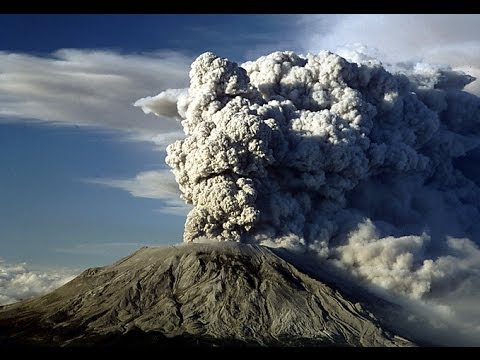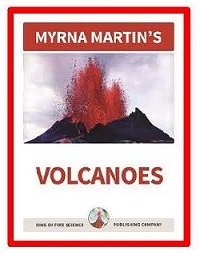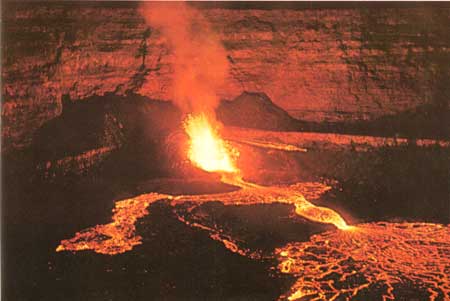Volcano Facts for Kids
Introduction
Great Hawaiian Island Shield volcanoes
Volcanoes are mountains that are created when molten rock is erupted on the surface of the Earth. Some of the largest mountains on Earth are the Hawiian Islands shield volcanoes. Thin layers of fluid basalt formed on the seafloor above a persisten hot spot in the middle of the Pacific Ocean.
Mauna Loa one of the most active volcanoes on Earth
The height of shield volcanoes in the oceans are measured from sealevel to their peak. Volcanoes on land are measured from their base to their peak. Mauna Loa is an enormous volcano that covers half the Island of Hawaii. The height of Mauna Loa is listed as 4 km (13,100 ft) high when its height is listed in books and on maps. Measure from sealevel to Mauna Loa's peak the great mountain is 5 km (16,400 ft) high. Mauna Loa is so heavy the base of the volcano forms a bowl shape that sinks below the seafloor another 8 km (26, 200 ft). Measured from its base on the seafloor to its summit. Mauna Loa is at 17 km (55,700 ft) high.
Vent of a volcano
The term volcano can also refer to the opening or vent through which molten rock and gases are expelled. The type and amount of gases contained in the magma, molten rock, helps determine the shape and size of a volcano.
Igneous rocks
Igneous rocks were once molten rock in the upper mantle and crust of the Earth. The molten rock cooled and solidified underground or above ground. All volcanic rocks form during a volcanic eruption that creates lava flows or is blown into the air.
Lava rocks are volcanic rocks that flowed out of the vent of a volcano in a lava flow. Tephra rocks were blown out of a volcano and were airborne for a period of time.
Hawaiian volcanoes
Persistent hot spot create shield volcanoes
The Hawaiian Islands have been built over a persistent hot spot in the middle of the Pacific Ocean. Molten magma from the upper mantle erupts on the ocean floor forming countless layers of basalt lava. The fluid lava forms a shield volcano. Shield volcanoes are made entirely of fluid lavas that form a volcano with gently sloping sides resembling a warrior's shield.
Loihi is a seamount off the coast of Kilauea volcano. Loihi is the newest member of a chain of volcanoes that formed over a hot spot in the middle of the Pacific Ocean. The chain of volcanic seamounts and islands stretches all the way to the North Pacific Ocean where they subduct beneath the North American Plate.

Mount Saint Helens a stratovolcano in the Cascade Mountains of North America USGS
stratovolcanoes
Formation of stratovolcanoes
Stratovolcanoes form on the continental side of subduction zones, which are areas where an oceanic plate is subducting beneath a continental plate. Stratovolcanoes form an arc of volcanoes on land. They can also form an arc of volcanic islands. The distance that separates each volcano from others in the chain is approximately ten kilometers. Arcs of stratovolcanoes surround the Pacific Ocean on the landward side of subduction zones.
Melting ocean crust
The water-soaked oceanic crust subducting beneath the continental crust in a subduction zone begins to melt at a depth of 100 to 250 km. Melting oceanic crusts creates plutons filled with molten rock. Recent scientific experiments suggest that the water-soaked basalt in the oceanic crust turns into andesite. Andesite is the principal rock erupted by stratovolcanoes.
Cinder cones
Small cone shaped volcanoes
Cinder cones are the simplest and most common type of volcano. Cinder cones are small cone shaped volcanoes with a crater at the top. They are usually less than 300 meters tall. The pyroclastic material on cinder cones originates from a single vent. Cinders can be any size although they are usually small rough round balls of cooled lava about the size of a walnut.
How a cinder cone forms
A cinder cone forms when a vent in the ground opens and pyroclastic material erupts into the air. The pyroclastic rocks pile up around the vent forming a mound of cinders. As the cinder cone grows, the sides become very steep.
The cinders near the crater form avalanches that flow down the side of the volcano carrying the cinders downward enlarging the base of the volcano. The avalanches form a steep-sided cone-shaped volcano with a crater at the top when the volcano becomes extinct.

Volcanoes are fascinating because all the rocks that make up large and small volcanoes were molten rock. Chapter in this book includes information on major types of volcanoes, different types of eruptions, and volcanic rocks produced by the volcanoes. Myrna

Click for More Information and to Order
Ocean Volcanoes
Dacite domes
Volcanic domes are small volcanoes composed of silica-rich lava that can reach sizes of 25 km3. Dacite domes often form in calderas or on the flanks of large stratovolcanoes. The lava oozes out of a vent like cold tar and covers the vent with a mass of rock.
Instead of breaking through to the outside of the dome, lava forces make their way into the center of the structure, forcing the older rocks away from the vent creating a layer of broken rocks on its surface.
Collapsing lava domes on the flanks of a stratovolcano
Lava domes have a crumbly outer crust with thick, steep cliff-like sides. Lava often plugs the vent creating enough pressure to collapse the dome. A pyroclastic flow of hot rocks and superheated gases flows away from the dome when it collapses.
What is magma
Magma is molten rock that is buoyant because it is lighter than the surrounding country rock. The gases dissolved in the molten rock expand as magma forces its way up through cracks in the Earth's crust toward it's surface. The magma when it reaches the Earth's surface becomes a lava flow or is blown out of the vent forming ash, lapilli and other forms of tephra.

Night view of the July 1961 eruption within Halemaumau. NPS photo by L. R. McBride
Types of Volcanic Eruptions
Strombolian eruptions
Strombolian eruptions are moderately explosive and characterized by intermittent eruptions of basalt lava from a crater at the summit of the volcano. Incandescent molten rock shooting high into the air produces high, arching rooster tails that can be seen above the top of the volcano during an eruption.
Other times lava shooting into the air looks like Roman candles on the Fourth of July. The eruptions eject lava bombs and lapilli into the air. Lava bombs form when tephra takes on a rounded shape while it is airborne. Lapilli are small lava rocks that form during an eruption that are often smaller than a walnut.
Vulcanian eruptions
Vulcanian eruptions are moderate to strong explosions from a central vent. The magma is thick and pasty. The main types of lavas associated with this type of eruption are andesite and dacite. The lava forms igneous rocks that contain 54% to 69% quartz.
The eruptions typically produce large volumes of ash that form mushroom shaped clouds alternating with eruptions of pyroclastic rocks. The pyroclastic material is predominantly lava bombs, bread crust bombs and blocks.
Peléan eruptions
The distinguishing feature of Peléan eruptions is a nuée ardente. A nuée ardente is a glowing avalanche of incandescent gas, ash, and rock fragments that form a pyroclastic flow as the dome collapses.
A French geologist who observed the eruption used the term nuée ardente, which is French for glowing clouds, in his written account of the eruption. Today geologists use the term to describe pyroclastic flows that were created when a dome collapses.
Plinian (Vesuvian) eruptions
Plinian eruptions are sometimes called caldera producing eruptions. They can occur after long periods of dormancy and are typically produced by stratovolcanoes with dacite and rhyolite lavas. The eruptions can be a few hours to many days long. The longest and deadliest eruptions are associated with rhyolite lavas.
The eruptions generate large eruption columns partly powered by expanding gases. The eruption column can spew ash 45 km into the air where they are carried by winds in the stratosphere around the Earth. Some eruptions cover large areas with pumice and ash. Pyroclastic flows form when part of the eruptive column collapses and rushes with hurricane force winds down the mountain destroying everything in their path.
Four major groups of volcanic rocks
There are four major groups of lava rocks: basalt, andesite, dacite and rhyolite. Lava rocks are classified primarily by their silica content. Quartz is a rock-forming mineral composed of silicon and oxygen. The amount of silica in igneous rocks divides rocks into four major groups.
Basalt is a dark, heavy lava that is fine-grained with low silica content. It is the most common volcanic rock on Earth. Basalt lava contains 45% to 54% silica. It is rich in ferromagnesian minerals. The dark heavy lava is hotter and more fluid than andesite, dacite and rhyolite. Mid-ocean ridges are created from basalt that originates in the Earth's upper mantle.
Andesite is of intermediate composition between basalt and dacite. It is usually light gray or brown and is the principal lava of stratovolcanoes. Andesite creates thick deep lava flows on the flanks of volcanoes when it oozes out of a vent. Andesitic lava is stiff and pasty (viscous) due to its high percentage of silica.
Dacite is an intermediate lava. It is usually light-colored with relatively high silica content and often forms lava domes in the calderas of stratovolcanoes or on their slopes.
Dacite is light-gray lava containing 62% to 69% silica that forms in subduction zones. Dacite can be extremely explosive because of its high silica content. It is intermediate in composition between andesite and rhyolite.
Rhyolite is a light-colored rock with the highest silica content. Rhyolite contains at least 69% silica and is usually deposited on the Earth's surface during Plinian eruptions. Rhyolite is associated with caldera eruptions and supervolcanoes.
PyROClastic rocks
Pyroclastic rocks are igneous rocks that are created during explosive eruptions. The term pyroclastic literally means fire broken. All pyroclastic rocks that were airborne during an eruption are tephra. Tephra can form from any type of lava and can be any size.
tephra
Three sizes of tephra
Ash is a fine-grained rock fragments less than 2 mm in size. Ash deposits will generally contain shards of glass, broken crystals, and rock fragments.
Lapilli are pea-size to walnut-size pieces of igneous rocks (2 mm to 64 mm).
Lava bombs and blocks are rocks larger than 64 mm in size. Lava bombs were semi-molten when airborne form an aerodynamic shape while flying through the air.
Tephra with special characteristics
Pele’s tears are lapilli size basalt lava that cools in the shape of a glassy teardrop.
Pele’s hair are long filaments of glassy basalt that form when molten fragments of lava are erupted during strong winds. Pele’s hair can reach 2 m in length.
Pumice is has many visible cavities from the expanding gases that were trapped in the magma before the rock cooled. Pumice forms when rhyolite and dacite lavas are blown out of a volcano during a violent eruption. The large amount of gas bubble holes in the rock lowers its density making the rocks light enough to float.
Cinders (scoria) are basalt rocks formed during Strombolian eruptions that contain vesicles. The gas bubble holes inside the rock formed when the molten rock cooled and solidified into solid rocks usally while they are airborne.
Bread crust bombs are a type of lava bomb that forms a thin rind of cooled lava on the outside of the molten rock while airborne. Upon landing, gases inside bread crust bombs continue to expand cracking the thin outer crust. The exterior of bread crust bombs resembles the crust of a loaf of bread when they cool.
Blocks are angular chunks of solid rock ejected during an eruption when solid rocks near the summit of a volcano break apart during violent eruptions.
Subduction Zone Volcanoes
Volcanoes form along narrow mountainous belts parallel to deep ocean trenches. More than six hundred volcanoes are now active on our planet. Most of the volcanoes are near the margins of continents where a continental crust and an oceanic crust collide.
Around the Pacific Ocean Plate volcanic arcs and island arcs have formed in subduction zones. Oceanic plates always subduct beneath continental plates because they are heavier. When two oceanic plates collide the older and heavier oceanic plate subducts beneath the younger oceanic plate.
Indonesia is an island nation There are 17,508 islands. Six thouand of the islands are inhabited. Most the volcanoes are part of the Sunda arc that is 3,000 kilometers long. Most of the volcanoes that form the islands are the result of the Australia Plate subducting beneath the Eurasia Plate.
Hot Spot Volcanoes
The great shield volcanoes of the Hawaiian Islands formed over a stationary hot spot in the middle of the Pacific Ocean.
Many unknown volcanoes are quietly erupting beneath the seafloor over hot spots in the ocean. Scientists are presently conducting research on some of these volcanoes off the coasts of Oregon , Washington, British Columbia , and Alaska.
The Yellowstone hotspot is a volcanic hotspot in the United States. It is responsible for large scale volcanic eruptions in Idaho, Montana, Nevada, Oregon, and Wyoming as the North American Plate moved over the hotspot.
Myths and legends about volcanoes
Early people thought volcanoes were the homes of gods and goddesses. They created myths and legends to explain how the actions of gods and goddesses caused volcanoes to erupt.
Origin of the term volcano
The term volcano comes from Vulcano, a volcanic island north of Sicily. The Roman god Vulcan was the unruly child of Jupiter and Juno. Volcanic eruptions were the material from Vulcan's forge as he fashioned bronze arrows for Apollo, armor for Hercules, and thunderbolts and lightning for Jupiter.
Greek legend about Zeus
Ancient Greeks thought that Zeus buried giants beneath the mountains and that volcanic eruptions were caused by their heavy breathing as they tried to escape.
Virgil, a famous author in ancient Greece, wrote that the eruptions of Mount Etna were the burning breath of , Enceladus, one of the giants as he struggled to free himself from his prison.
Pele, Goddess or Volcanoes
Hawaiians believed that Pele, Goddess of Volcanoes, is both the creator and destroyer of land. She has the power to make volcanoes erupt by throwing molten fountains of rock into the air or causing large lava flows.
KIDS FUN Science Bookstore
Check out Myrna Martin's award winning textbooks, e-books, videos and rock sets. The Kids Fun Science Bookstore covers a wide range of earth science topics. Click here to browse.










